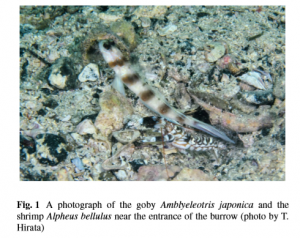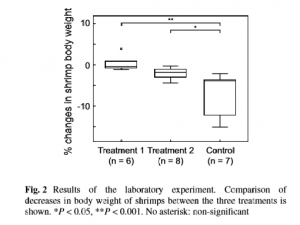A novel aspect of goby–shrimp symbiosis: gobies provide droppings in their burrows as vital food for their partner shrimps
By SRC intern, Andriana Fragola
The goby A. japonica and shrimp A. bellulus symbiosis are a perfect example of a mutualistic relationship between two marine animals. The goby lives in the shrimp’s burrow, which lends it shelter, and the goby warns the shrimp if there is a predatory threat nearby (Kohda et al. 2017). It has been hypothesized that the shrimp actually eats the goby’s droppings as its primary food source (Kohda et al. 2017). Kohda and colleagues conducted a laboratory experiment to replicate this relationship, and examine if this feeding behavior is actually occurring.

Field studies were conducted to examine the goby and shrimp interactive behavior. Between the shrimps, A. bellulus and the gobies A. japonica it was observed that the shrimps were not foraging much outside of their burrow, and the gobies were never really observed defecating outside of their burrow (Kohda et al. 2017). Most burrowing organisms do not defecate inside of their burrows – likely to be an act to keep it cleaner (Kohda et al. 2017). If the shrimp is using the goby’s droppings as a nutritional supplementation, then it would not be an issue of keeping the burrow clean because the droppings would still be removed via consumption by the shrimp (Kohda et al. 2017). The animals were collected at Morote Beach, Ehime Prefecture, Japan and were then studied in a laboratory setting.
The gobies and shrimps were kept in tanks with the burrow being a vinyl tube with one open side up against the glass wall of the tank for visual observation (Kohda et al. 2017). This experiment took place over a 2 week period. The shrimp were weighed prior to and after the experiment to determine if they had lost weight when they had no access to food other than the goby droppings (Kohda et al. 2017). In treatment 1, in order to make the goby feed inaccessible to the shrimp, it was placed on a suspended board away from the entrances of the burrows (Kohda et al. 2017). This way the goby could reach the food by swimming, but the shrimp could not and had to rely entirely on the goby droppings for nutrition. In treatment 2, the gobies and shrimp were kept in different tanks, and the researchers collected the goby faeces and then placed them up at the top of the shrimp’s burrow (Kohda et al. 2017). The shrimps were noted to come to the entrance and collect the faeces and bring them back down into the burrow and eat them (Kohda et al. 2017). A control tank was set up where the shrimp were isolated from the gobies, and were not fed during the entirety of the experiment (Kohda et al. 2017).
Final observations noted that the gobies stayed very close to the burrow unless they were feeding, and were never observed defecating outside of the burrow (Kohda et al. 2017). The shrimp were never noted to forage outside of the burrow unless they were taking algae off of the rocks near the burrow entrance (Kohda et al. 2017). Between the two treatments, there was not a significant difference between body weight of shrimps prior and after the experiment (Kohda et al. 2017). But there was a significant decrease in shrimp body weight in the control groups where they were isolated from the gobies (Kohda et al. 2017). Meaning that the shrimp were able to maintain a stable body weight with only the goby faeces as food (Kohda et al. 2017).

Understanding behavioral relationships between species is incredibly important for conservation initiatives. Learning that two species heavily rely on each other to thrive is vital in establishing protection for them. In a mutualistic relationship similar to this, both species need to be protected because if one is missing, they cannot perform their usual behaviors, and do not have that resources they typically rely on. For example, the droppings of the goby being a primary food source by the shrimp. This study demonstrated that solely having goby droppings as food is enough to maintain the shrimp’s weight even without other nutritional sources available (Kohda et al. 2017). Therefore the goby is a very beneficial to the shrimp as a partner, and without these mutualistic relationship the shrimp would have a much more limited food supply, and the goby would not have a burrow to reside in.
Works cited
Kohda, M., Yamanouchi, H., Hirata, T., Satoh, S., & Ota, K. (2017). A novel aspect of goby–shrimp symbiosis: gobies provide droppings in their burrows as vital food for their partner shrimps. Marine Biology, 164(1). doi:10.1007/s00227-016-3060-2
